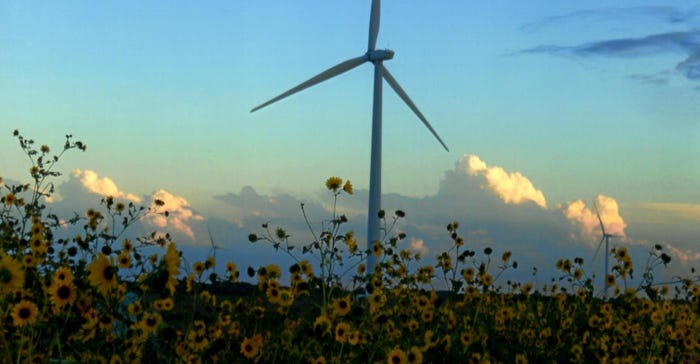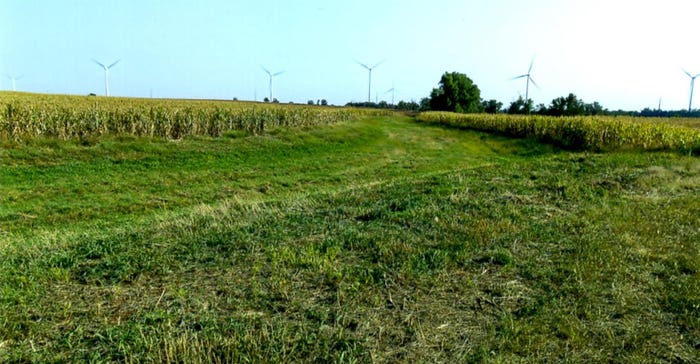
Harper County farmer Jim Robb has a fascination with on-farm research, whether it be no-till farming, cover crops, companion crops or the weather.
"I’m an ag economist by education, so I like statistics and data collection," he says. "I always keep records on what I experiment with and, of course, I track things like rainfall at given areas on my farm ground so I can crunch the numbers on how much rain any one crop got in a given year. That can be valuable when I’m making decision about what to grow and what varieties to plant."
That explains why he has nine rain gauges at different locations. Two of those are located inside the Flat Ridge II wind farm, two are located about 14 miles southeast of the wind farm and five are about 28 miles south of the wind farm.
In addition, he has recorded data from a National Oceanic and Atmospheric Administration rain gauge about 17 miles south of the wind farm.
He says he has routinely recorded rainfall on notebook calendars that he picks up from the coops in Danville and Anthony.
A few weeks ago, he decided to enter all of his data into a spreadsheet so he could make comparisons of the rainfall at different locations.
 FARMING THE WIND FARM: Harper County farmer Jim Robb photographed this sunflower field beneath a wind turbine on his farm. He has collected rainfall data both on and off the wind farm for the last five years and found that it consistently rains more downwind of the turbines.
FARMING THE WIND FARM: Harper County farmer Jim Robb photographed this sunflower field beneath a wind turbine on his farm. He has collected rainfall data both on and off the wind farm for the last five years and found that it consistently rains more downwind of the turbines.

When he printed out that spreadsheet, something got his attention. He went back and double-checked his numbers.
"Consistently over five years, more rain fell inside the wind farm than outside it," he says. "It didn’t matter if it was wet year or a dry year. Inside the wind farm, rainfall increased by about 20%. In addition, rain gauges located within 500 feet of a turbine tower appear to have recorded more rain that those 1,500 feet from the same tower."
Robb was curious about how other weather events might be changed inside a wind farm. So, he asked Joe Mills, performance manager at Flat Ridge II, for a map of the farm’s turbines.
"At first, he told me no," Robb says. "Then, he apparently changed his mind, because there was the map in my email inbox."
Robb consulted with three hail insurance providers to learn which areas in the region had sustained the most losses from hail. Then he mapped them out based on which areas had the highest hail premiums according to prior claims and which had the lowest.
"I overlaid the wind farm map on the grid of the region," he says. "And wow, all the lowest premiums were inside the wind farm. We’re talking by a lot — like half."
Robb says he hopes that his research will lead other farmers who have wind turbines on their property to replicate his study.
Robb consulted with a meteorologist at the National Weather Service office in Wichita, and with state climatologist Mary Knapp, to see if they had ideas on what might be a scientific reason for the differences in rainfall and hail.
"The theory is that the turbulence created by the turbines created air disturbance that caused the raindrops to combine and gain enough weight to fall to the ground," he says. "And, [the meteorologist] said the same turbulence would interrupt the repeated updraft of hail that allows it to grow in size. That’s one theory at least."
Knapp says she was impressed with the length of time of the data study, which shows five years of consistent difference in rainfall and hail patterns. Particularly interesting was that the percentage of difference remained the same in years with higher and lower rainfall.
 GROWING CROPS: Flat Ridge II wind farm forms a backdrop for growing crops on the Robb farm in Harper County. Data collected by farmer Jim Robb indicates there may be an unforeseen benefit to farming in proximity of a wind farm: more rainfall.
GROWING CROPS: Flat Ridge II wind farm forms a backdrop for growing crops on the Robb farm in Harper County. Data collected by farmer Jim Robb indicates there may be an unforeseen benefit to farming in proximity of a wind farm: more rainfall.

But, she cautions, one data set doesn’t really prove anything, and correlation doesn’t necessarily mean causation.
"It’s interesting and it’s fun to talk about," she says. "But it doesn’t necessarily mean anything unless you can show it holds true for other wind farms in other locations of the rainfall pattern across the state."
She, too, hopes that more people will be willing to collect data to see if results are similar.
"I’d like to see something in Ellsworth County or out in Ford County," she says.
Knapp says farmers who are interested in sharing rainfall data can sign up for the COCORAHS (Community Collaborative Rain, Hail and Snow) network and get a free rain gauge.
"I think that would be a good route because all the gauges would be the same and there are instructions on how to collect and report the data, so we would be getting consistent information," Knapp says. "It would be interesting."
For his part, Robb says he plans to change some of his cropping patterns to put crops with higher water needs such as corn or soybeans, on the land that is beneath the wind turbines.
"I think five years of consistent data is enough to convince me to make that decision," he says.
About the Author(s)
You May Also Like




